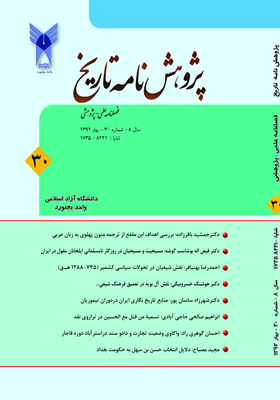منابع تاریخ نگاری ایران دردوران تیموریان
محورهای موضوعی : مباحث معرفتی و روش شناختی و تاریخ پژوهی
1 - استادیارگروه تاریخ
دانشگاه آزاد اسلامی، واحد شبستر
کلید واژه: تاریخ نگاری, دوران تیموریان, منابع تاریخی, منابع ادبی, منابع جغرافیایی, سفرنامهها,
چکیده مقاله :
یکی از مسائل بسیارمهم درهر بخش از تاریخ، منابع مختلفی است که در تاریخ نگاری هر دوره مورد استفاده قرار می گیرند و یا به نوبه خود از منابع تاریخ نگاری آن دوران محسوب می شوند. در دوران سلجوقیان حاکمیت اندیشه ایرانشهری برذهن مورخان ایرانی، اولین تحول را در اندیشه آنان به جای گذارد. در دوران حکومت مغول- ایلخانی، مورخان به نگارش تواریخ جهانی پرداختند و دومین تحول مهم در اندیشة این قشر ایجاد گردید. پس از تشکیل حکومت تیموریان، مورخان این دوران سنت های تاریخی نگاری ایرانی را به ارث بردند، با این وجود تاریخ نگاری در این دوران با اینکه از ویژگی های خاصی نیز برخوردار بود، سه مرحله را پشت سرگذاشت: دوران تیمور، شاهرخ و سلطان حسین بایقرا. در مقاله حاضربا توجه به این مراحل سه گانه صرفا منابع تاریخ نگاری ایران در دوران تیموریان مورد بررسی قرارگرفته است و محور کلیدی آن بررسی اجمالی منابع مختلف تاریخ نگاری در دوران موردنظر و نیز دریافت گرایش های متفاوت نویسندگان و مورخان این دوران درنگارش مطالب است. بدین منظور تلاش گردیده تا با استفاده از منابع تاریخی و مطالعات نوین مربوط به این دوره و با توجه به روش تحلیلی- تاریخی به گردآوری وتدوین مطالب پرداخته شود.
The subject variety of historical sources- as literary, geographical and religious books– is the one of the most important issues in historiography. This different source which used in compilation of history in every period, step by step, became as the historical sources of this period. In the Seljuk era “Iranshahri thought” dominated the minds of Iranian historians, and it makes the first change in historians' thought. During the Mughal-Ilkhanid’s era, historians began writing global histories, and as result, the second major change occurred in historical thought. After the Establishment of the Timurid rule, historians of this period inherited the traditions of the former Persian historians. Historiography of this period, despite the fact that certain features are- that addressing it requires a separate article- three steps behind: Timur, Shahrokh and Soltan Hosein Baygar's period. The key focus of this paper is a cursory examination of different historiography sources in Timurid era and understanding the different orientation of the authors and historians in writing this content. Therefore attempted to use the sources of modern historical studies of the period and the historical analysis and by considering the new methods, subjects and data were collected and compiled.

